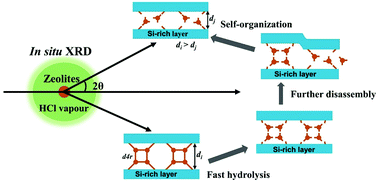In situ synchrotron X-ray diffraction reveals the disassembly–organisation mechanism of germanosilicate zeolites in HCl vapour†
Abstract
The assembly–disassembly–organisation–reassembly (ADOR) approach extends the synthesis of new zeolites. Understanding the disassembly and organisation mechanism is important to optimise the post-treatment process on germanosilicate zeolites. In situ synchrotron X-ray diffraction technique was applied to study the mechanism of these two steps in HCl vapour, which it is often unfeasible to capture using conventional ex situ characterisation. Three germanosilicate zeolites with different pore systems, i.e.UTL, UOV and IWR, were selected as models to compare the reaction behaviours. Three key steps, including fast hydrolysis of d4r units (ca. 1 min), further disassembly (ca. 3–5 min), and self-organisation after disassembly (ca. 2–3 min), were observed in the HCl acid vapour. An unusual lattice expansion of the intralayer was observed at the very beginning of the hydrolysis process in IWR, while the UTL and UOV showed continuous shrinkage. Owing to the diffusion differences related to the structural features, extra-large-pore UTL zeolite showed faster kinetics than the other two large-pore zeolites, although UTL zeolite has much larger crystals. These findings potentially guide further modification of the treatment parameters in the ADOR process to prepare new zeolites.



 Please wait while we load your content...
Please wait while we load your content...